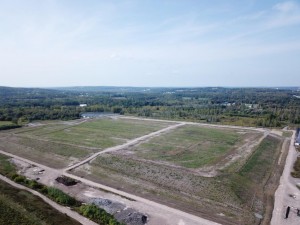Honeywell has completed the dredging and capping of Onondaga Lake. Lake dredging was completed in November 2014, a year ahead of schedule. About 2.2 million cubic yards of material were removed from the bottom of the lake using hydraulic dredges. Capping was completed in December 2016. More than 3 million cubic yards of material consisting primarily of sand, activated carbon and stone were used to cap 475 acres of the lake bottom, providing a new habitat layer.
Construction of the cover system for the consolidation area, which holds material removed from the lake, is complete. The cover system consists of several feet of soil and a sealed liner to permanently encapsulate the geotextile tubes. Native grasses have been planted over the entire area. Experts at SUNY-ESF and Audubon provided critical input on selection of perennial native grasses and vegetation, as well as best management practices to foster sustainability.
A Community Health and Safety Plan was developed and approved by the New York State Department of Environmental Conservation (DEC) in consultation with the New York State Department of Health and the U.S. Environmental Protection Agency on May 26, 2012. The plan outlines the activities and measures taken to protect the community and environment during operations.
Results from the air monitoring program indicate that operations at the lake and the consolidation area, which holds material removed from the lake, have met the project’s health and safety performance criteria.
Air was monitored during construction activities for dust and total volatile organic compounds (TVOCs) to ensure concentrations at the perimeter of the work zones remained below criteria established by the Community Health and Safety Plan. According to DEC, “total VOC levels detected at the perimeter monitoring locations comply with the standard established for protecting public health.” Additionally, 12-month averages of individual VOCs were below regulatory criteria during operations.
- Click here for the first year results.
- Click here for the second year results.
- Click here for the third year results.
- Click here for the fourth year results.
Odor Monitoring
During construction, odors were checked at the air monitoring stations along the work perimeter of the consolidation area by trained professionals. For more information about odor monitoring, see here.
The aerial photographs below show the locations of the fixed monitors during construction. To view the data collected, select the date from the drop-down list and click “Change.” Move your cursor over a monitor icon and click on Dust Data or Total VOC Data. If data from a particular monitor are unavailable, this will be stated next to the monitor icon. Wind direction and wind speed information are also available for each monitoring day below the map. If you would like more information, please call 315.552.9784.






